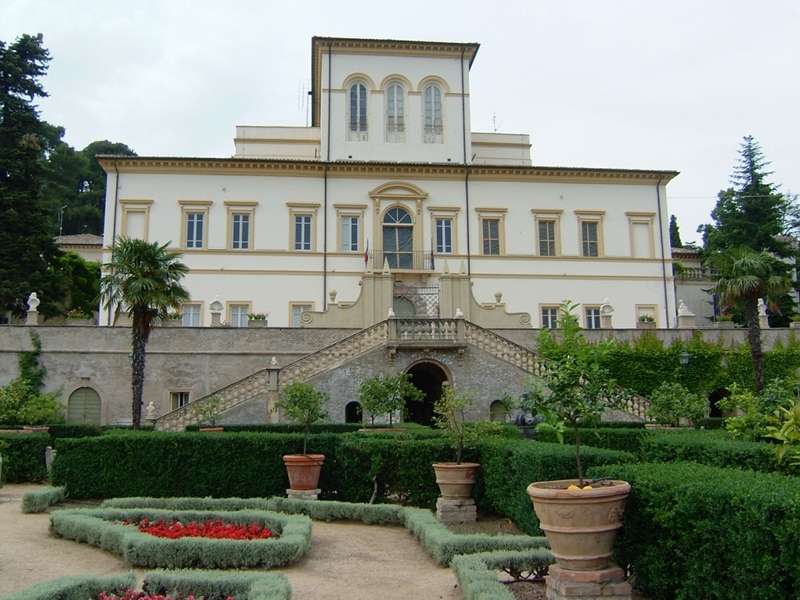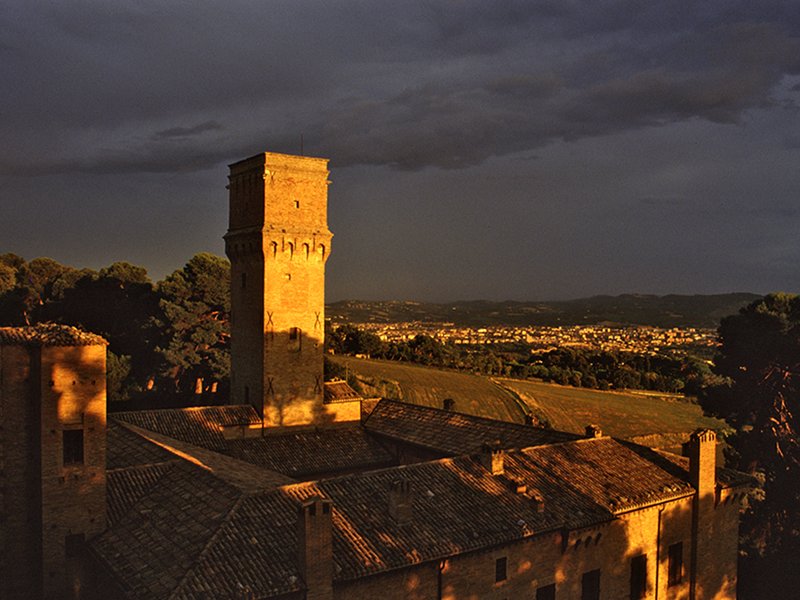Points of Interest
Casteldimezzo
The former Castrum Medi - also called Galliolo or Gaiola or Garzoleto or Castel Bernardo - is situated at more than 200m above sea-level. From it you can enjoy a wonderful view and see on the horizon the Castle of Gradara, San Marino, and the "gibbo" of the Catria.
In Casteldimezzo it is still possible to see part of the boundary walls which once alternated with a number of keeps, while the fortress has been replaced by a famous restaurant.
The Church dedicated to the Saints of the town of Ravenna, Apollinare and Cristoforo, is particularly interesting since it preserves a 15th century Crucifix, about which an adventurous tale is written on a memorial stone placed in the Church in 1652.
Further info (Italian text)
Fiorenzuola di Focara
It is one of the four castles (together with Casteldimezzo, Gradara, and Granarola) which were built with defensive aims between the 10th and 13th centuries in the border area between the Church of Ravenna and the Church of Pesaro first, and then between the Malatesta of Rimini and those of Pesaro after.
The original name of the village was Fiorenzuola: the specification "of Focara" was added only in 1889, and it was probably given by the fact that there was in the past the presence of fires used to signal the position to sailors, or of the so-called "fornacelle" where bricks and terracottas were baked (from the dialect of Romagna, fuchèr or fugher, that is making fire to bake the bricks).
Just a few evidences have remained of the history of the town: some 17th-18th century portals, and some knockers at the portals. Besides the ruins of the walls, it is interesting the door with the plate reporting Dante's verses about a fact occurred in the sea in front of the town (Inferno XXVIII). Moreover, there is Sant'Andrea Church dating back to the 12th century.
Further info (Italian text)
Santa Marina
Contrary to the other historical towns of San Bartolo Park, we have only indefinite and fragmentary news of this small town overhanging the cliff. We do not have ancient legends having Santa Marina as protagonist, even if the survival of the town till present times, despite the erosion of the coast and the hostile historical events, leads us to believe that it was an important center.
Further info (Italian text)
Jewish Cemetery
Situated on San Bartolo hill, on a natural slope facing the east, the cemetery witnesses the centuries-old presence of a Jewish nucleus in the town of Pesaro, which contributed to shape the cultural and civil identity and the local economy.
It was established at the end of the 17th century by a particularly flourishing and large community, grown with the arrival of some families from Ancona (after their flight because of the destruction of the quarter for a fire) and from Portugal.
Further info (Italian text)
Colombarone
The historical importance of the territory of San Bartolo Park is confirmed by the discovery of the archaeological site of Colombarone which, thanks to the success of the latest excavation campaigns, has been defined a "small Villa Armerina".
Further info (Italian text)
Villa Caprile
Surrounded by an Italian garden, it was built in 1640 for the Mosca family coming from Bergamo.
The villa, whose architect is unknown, was built in the characteristic style of the Marches region, on more terraced levels going from the 18th oratory in the highest part to the lateral wings of the same century, which have been united to the originary 17th century villa. In the park there is the so-called "theater of the cypresses" dating back to the 17th century, which has been subsequently rebuilt.
Villa Caprile is famous for its water games made possible by a big gallery entering the hill for almost two kilometers to exploit its waters. In the past, these games were one of the most important forms of entertainment for the people from Pesaro.
Many illustruous persons came to this place: among them Giacomo Casanova in 1792, Stendhal, the Duke Ferdinando IV from Parma, and Carolina from Brunswick in 1817-1818 before moving to Villa Vittoria.
In 1876 the Villa was bought by the "Accademia Agraria" ("the Agricultural Academy") which because of its economic difficulties had to sell it in 1924 to the Province of Pesaro e Urbino.
Today it is houses "Istituto Agrario A.Cecchi".
Further info (Italian text)
Villa Imperiale
The architectural complex enjoys a wonderful position on the mountainside of Mt. Accio - today Mt. San Bartolo - overlooking the valley of the river Foglia. The villa, one of the most beautiful Reinassance-style residences, was built in two stages: the most ancient one dates back to the second half of the 15th century and was commissioned by Alessandro Sforza; the first stone was placed by the Emperor Frederick III, from here the definition of "imperiale" (imperial).
The architecture is sober, and the building is square and dominated by a watchtower over the entrance portal bearing the coat of the Sforza. The other part of the structure was built by Francesco Maria della Rovere, who assigned the architectonic project to Girolamo Genga and whose aim was to transform it into a meeting and leisure place for famous artists and men of letters (Bernardo and Torquato Tasso, Baldassarre Castiglione, Pietro Bembo).
Further info (Italian text)
Vallugola
It was an important landing place at the time of the Romans (or even at the time of the Greeks for the export of excellent wine) active until the beginning of the 17th century, but which was abandoned after the reconstruction of the port of Pesaro (1614).
You could easily enter Vallugola through the Via Flaminia.
It seems that the toponym means "Valley of the little wines": it is possible, since the wine, together with flour, wheat, favas, and figs, was on of the traded products.
Further info (Italian text)
Gabicce Monte
The "Castrum Ligabitij" or "Ligabicij" is quoted in a papal bull since 998 and probably derives by the name of the Castle's founder. It followed the destiny of the surrounding Castles: first under the Church of Ravenna, and then under the Town of Rimini in struggle with the town of Pesaro.
The Church of Sant'Ermete was built within the Castle and was subject to the parish of San Cristoforo. It seems to be of Romanesque style, while the bell tower is more recent. Within it there are a 15th century wooden Crucifix and the 15th century "Madonna del latte" from the school of the Marche and by an unknown author.
After the last war, only some parts of the Castle remained: pieces of walls and the entrance. Today, nothing has been preserved.
Further info (Italian text)








